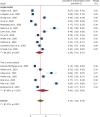Prevalence and Risk Factors of Thromboembolism among Patients With Coronavirus Disease-19: A Systematic Review and Meta-Analysis
- PMID: 33074717
- PMCID: PMC7592333
- DOI: 10.1177/1076029620967083
Prevalence and Risk Factors of Thromboembolism among Patients With Coronavirus Disease-19: A Systematic Review and Meta-Analysis
Abstract
Emerging evidence shows that the recent pandemic of coronavirus disease 19 (COVID-19) is characterized by coagulation activation and endothelial dysfunction. This increases the risk of morbidity, mortality and economic loss among COVID-19 patients. Therefore, there was an urgent need to investigate the extent and risk factors of thromboembolism among COVID-19 patients. English-language based databases (PubMed, Cumulative Index to Nursing and Allied Health Literature, EMBASE, and Cochrane library) were exhaustively searched to identify studies related to prevalence of thromboembolism among hospitalized COVID-19 patients. A random-effects model was employed to estimate the pooled prevalence of thromboembolism. The pooled prevalence of thrombotic events was computed using STATA 16.0 software. Heterogeneity analysis was reported using I2. A total of 19 studies with 2,520 patients with COVID-19 were included. The pooled prevalence of thrombotic events of hospitalized patients with COVID-19 was 33% (95% CI: 25-41%, I2 = 97.30%, p < 0.001) with a high degree of heterogeneity across studies. Elevated D-dimer hospitalized in the intensive care unit and being under mechanical ventilation were the most frequently associated factors for the development of thrombotic events. The pooled prevalence of thrombotic events in COVID-19 patients was 33%. The prevalence of thrombotic event is variables on the basis of study design and study centers. Several risk factors such as, elevated D-dimer, hospitalized in the intensive care unit and being under mechanical ventilation, were the most frequently reported risk factors identified. Therefore, healthcare professionals should consider these risk factors to optimally manage thromboembolism in COVID-19 patients.
Keywords: COVID-19; prevalence; risk factors; thromboembolism.
Conflict of interest statement
Figures







References
-
- Di Nisio M, van Es N, Büller HR. Deep vein thrombosis and pulmonary embolism. Lancet. 2016;388(10063):3060–3073. - PubMed
-
- Tagalakis V, Patenaude V, Kahn SR, Suissa S. Incidence of and mortality from venous thromboembolism in a real-world population: the Q-VTE Study Cohort. Am J Med. 2013;126(9):832 e13-e21. - PubMed
-
- Lyman GH, Culakova E, Poniewierski MS, Kuderer NM. Morbidity, mortality and costs associated with venous thromboembolism in hospitalized patients with cancer. Thromb Res. 2018;164( Suppl 1):S112–S118. - PubMed
Publication types
MeSH terms
LinkOut - more resources
Full Text Sources

